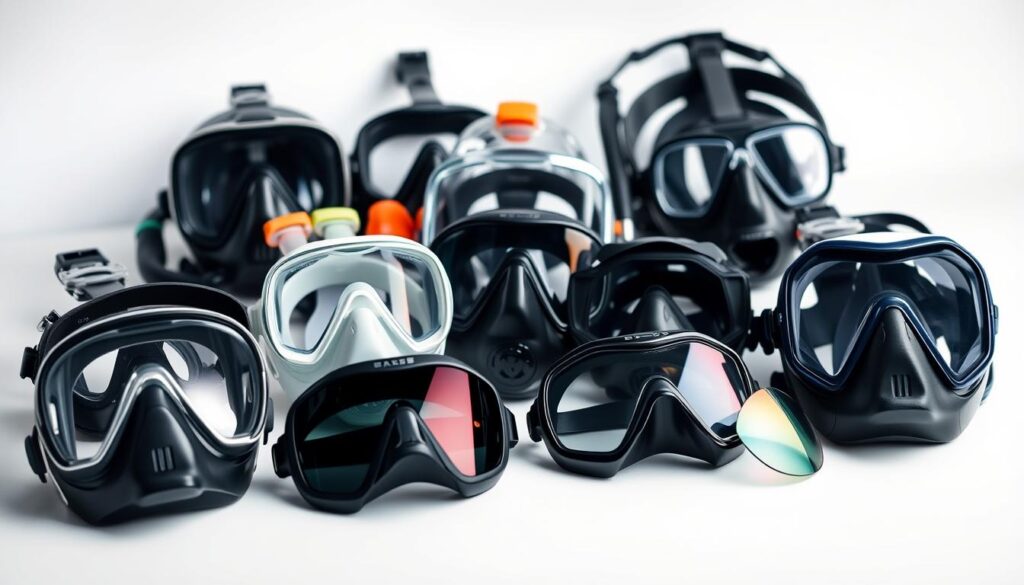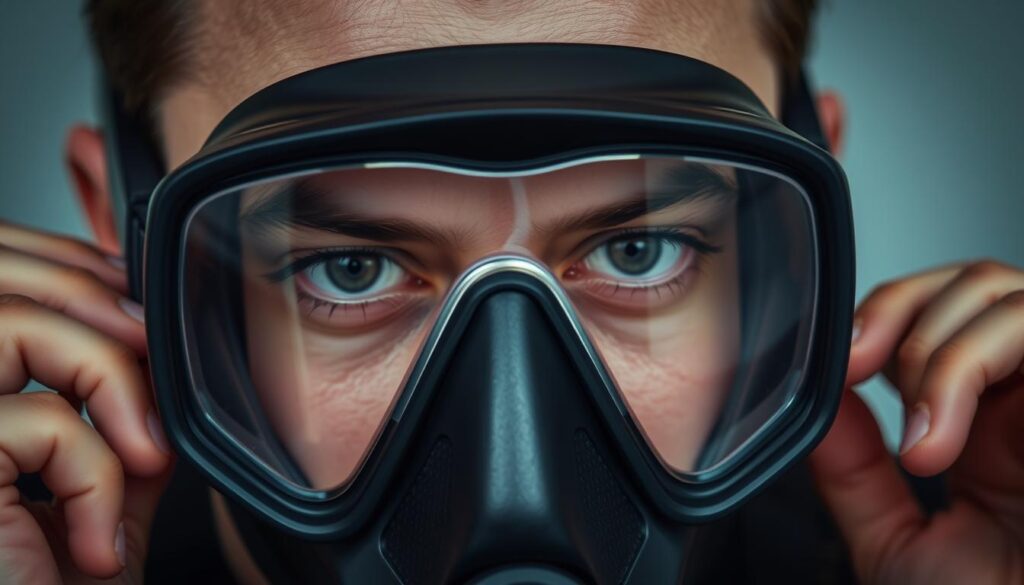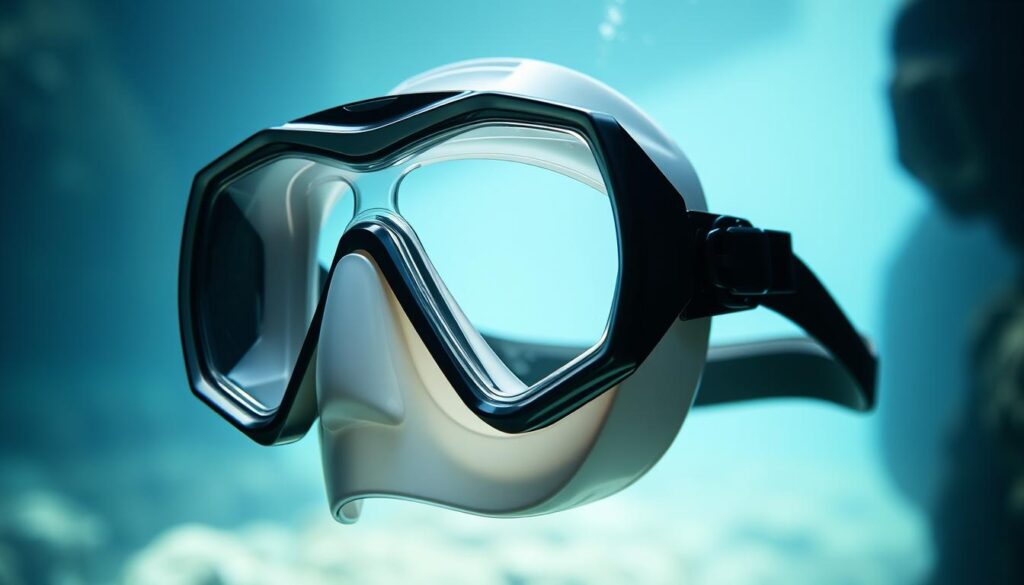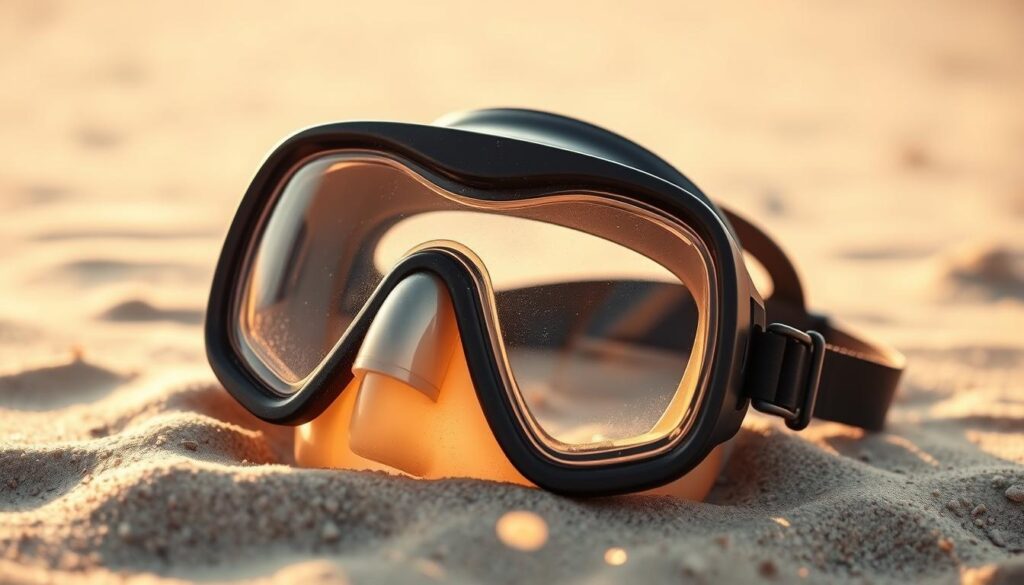Choosing the right scuba mask is key for a safe and fun dive. A dive mask makes a bubble of air for your eyes. This lets you see clearly underwater.
A good dive mask makes things clearer and feels comfy. There are many features to pick from. This guide will show you how to pick the best dive mask.
Key Takeaways
- Understand the importance of a proper fit for your dive mask.
- Learn about the key features that enhance diving comfort and safety.
- Discover how to prevent fogging and maintain clear visibility.
- Explore the different types of dive masks available.
- Find out how to choose the right dive mask for your diving needs.
The Importance of a Quality Scuba Mask
Scuba diving needs a good mask fit. A quality mask is key for safety and fun.
How Your Mask Affects Your Diving Experience
A proper mask fit makes diving better. A good mask fit lets you see marine life clearly. It also keeps you comfortable.
Safety Considerations
Safety is very important in scuba diving. A good mask fit keeps water out. This helps avoid panic or disorientation underwater.
“A good scuba mask is like a good pair of eyes; it helps you see the underwater world clearly and safely.”
The table below shows the difference between a good and bad mask fit:
| Feature | Well-Fitting Mask | Poorly Fitting Mask |
|---|---|---|
| Comfort | High comfort level, no pressure points | Discomfort, potential for pressure points |
| Water Leakage | Minimal to no leakage | Frequent leakage |
| Safety | Enhanced safety due to clear vision and comfort | Reduced safety due to potential for fogging or leakage |
In conclusion, a quality scuba mask is crucial. It makes diving safe and fun. A proper mask fit is essential for a great dive.
Understanding Different Types of Scuba Masks
Divers have many scuba mask choices. These include single lens, dual lens, and more. The mask you pick can change your dive. It affects how comfortable you are, how well you can see, and how much fun you have.
Single Lens Masks
Single lens masks are simple and give a wide view. They are often frameless, which helps you see more around you. These masks are made from strong glass or plastic. They let you see clearly underwater.
They are great for divers who want to see everything around them. And they like a simple design.
Dual Lens Masks
Dual lens masks have two lenses, one for each eye. They help with pressure and fit better for some. These masks have frames and can fit different lenses, like for glasses.

Multiple Lens Masks
Multiple lens masks are not as common but have cool features. They can make things look bigger or have special coatings. They are great for underwater photos or watching fish.
But, they might be more complicated and heavier.
Frameless vs. Framed Designs
Mask design is important. Frameless masks are sleek and let you see more. Framed masks are stronger and easier to replace lenses.
Think about what you want before choosing.
In short, knowing about scuba masks is key. Whether you want a single lens, dual lens, or something special, there’s a mask for you. It will make your dive better.
Essential Scuba Mask Buying Guide Considerations
Choosing the right scuba mask is key. It should be comfy, clear, and safe underwater. A good mask makes diving better.
Material Quality
The material of a scuba mask is very important. It affects how long the mask lasts and how comfy it is. Masks usually have tempered glass lenses. This glass is strong against scratches and heat.
Look for masks with strong, soft skirts. These skirts help the mask fit well and stay on your face.
Lens Technology
Lens tech is a big deal for scuba masks. Today’s masks have anti-reflective coatings. These coatings help you see better by reducing glare.
Some masks also have special lenses for people who need glasses. This means you can see clearly underwater without extra glasses.
Field of Vision
The view you get from a scuba mask is very important. A wide view lets you see more without moving your head. Masks with big lenses or special designs offer better views.
Color Choices and Their Impact
The color of your mask matters. It’s about looks and how easy it is to see. Bright colors are easier to spot if you lose your mask. But, color doesn’t really change how you dive.
Think about what you like and how it might help you. Pick a color that looks good to you and might be useful.
When you think about material, lens tech, view, and color, you can find a mask that’s just right. It will make your dives better and more fun.
Finding the Perfect Mask Fit
Finding the right scuba mask fit is key for a great dive. A good fit means you can see clearly and stay dry. It makes your dive better and safer.
The Vacuum Test Technique
The vacuum test is a simple way to check if your mask fits. Put the mask on without the strap and breathe in through your nose. If it sticks to your face, it’s a good sign.

Face Shape Considerations
Face shapes affect mask choices. For flat faces, masks with a thick skirt work best. Round faces need flexible masks.
Knowing your face shape helps pick the right mask. This makes diving better.
Facial Hair Challenges and Solutions
Facial hair can make it hard to get a good seal. Beards and mustaches can let water in.
Trimming hair where the mask sits helps. Or, use a mask made for facial hair.
Strap Adjustment and Comfort
Adjusting the strap right is important. It should be snug but not too tight. Too tight can hurt your head.
A good strap keeps the mask on without hurting. This makes diving more comfortable.
Lens Materials and Construction
The lens material and construction of a scuba mask are key. They affect how well the mask works and how long it lasts. A good lens makes diving better, safer, and more comfortable.
Tempered Glass vs. Plastic
Scuba masks use tempered glass or plastic lenses. Tempered glass is scratch-resistant and clear. It’s a favorite among divers. Plastic lenses are lighter and safer, but not as clear.
Choosing between glass and plastic depends on what you need. Glass is better for seeing, but plastic is safer and lighter.
Single vs. Multiple Window Construction
Scuba masks have single or multiple windows. Single lens masks give a clear view and don’t fog up easily. Multiple lens masks offer a wider view and can fit prescription lenses.
It’s up to you whether you want a single or multiple window mask. Single lens masks are simple and clear. Multiple lens masks are for those who need corrective lenses.
Optical Lenses for Prescription Needs
Optical lenses are for divers with vision needs. They help you see underwater clearly. This is great for those who need glasses every day.
These lenses come in many prescriptions. They can be made to fit any mask. This is very helpful for divers who need glasses.
Skirt Materials and Design Features
The skirt of a scuba mask is very important. It makes diving more comfortable and keeps water out. A good skirt seals well around your face.

Silicone Quality and Durability
The skirt is usually made of silicone. It’s durable and comfy. Durable silicone skirts last a long time and are easy to clean.
Benefits of silicone skirts include:
- They are flexible for a good fit
- They don’t get damaged by saltwater
- They are easy to clean
Clear vs. Opaque Skirts
Scuba masks have clear or opaque skirts. Clear skirts let you see more. Opaque skirts hide the mask’s inside, which might be less distracting.
Low Volume vs. Standard Volume Designs
The skirt’s volume is also important. Low volume masks are easier to clear water from. Standard volume masks might be more comfy but harder to clear.
Things to think about when choosing a mask include:
- How easy it is to clear water
- How comfy and fitting it is
- What you prefer and your diving experience
Effective Fog Prevention Techniques
Stopping fog on your scuba mask is key for a great dive. Fog happens when warm air hits the cooler mask lens. But, there are ways to stop it.
Commercial Anti-Fog Solutions
Many anti-fog products are made just for scuba masks. They come as sprays, gels, or wipes. These items put a layer on the lens that stops water from turning into fog.
Popular Commercial Anti-Fog Products:
- Anti-fog sprays that are easy to use and last a long time.
- Gels that give a strong fog shield.
- Pre-treated wipes for easy use.
DIY Anti-Fog Methods
If you don’t like commercial products, there are DIY ways to fight fog. Rubbing a bit of toothpaste on the lens and rinsing it off works well. You can also use saliva, but it’s not the best for long dives.
| DIY Method | Effectiveness | Convenience |
|---|---|---|
| Toothpaste | High | Moderate |
| Saliva | Low to Moderate | High |
Proper Pre-Dive Preparation
Getting ready before you dive is important too. Make sure your mask is clean and dry. Don’t touch the inside of the lens to avoid oils from your skin causing fog. Keep your mask in a case and don’t leave it in the sun.
Using these tips together can make diving much clearer and more fun.
Mask Care and Maintenance
Keeping your scuba mask in good shape is very important. It helps your mask last longer and keeps you safe while diving. A clean mask works better and feels more comfortable.
Cleaning After the Dive
Always rinse your scuba mask with fresh water after diving. This removes salt and dirt. Use a soft cloth to clean the lens and skirt gently.
For a deeper clean, a mild soap solution is okay. But make sure to rinse it well. This stops any soap from causing irritation or fogging.
Storage Best Practices
Storing your scuba mask right is very important. Put it in a protective case or bag. This keeps it safe from other gear and accidental bumps.
Don’t leave your mask in the sun or hot places. The sun and heat can damage it over time.
Extending Your Mask’s Lifespan
Regular checks are key to making your scuba mask last longer. Look for cracks in the lens or wear on the skirt. Replacing old parts, like the strap, keeps the mask in good shape.
Also, stay away from harsh chemicals. They can harm the mask’s materials.
By taking care of your scuba mask, it will last for many dives. Follow these tips to keep your mask reliable and safe.
Special Considerations for Different Diving Environments
Different diving places need special masks for safety and fun. Divers must think about the water’s challenges when picking a mask.
Cold Water Diving Mask Requirements
Cold water diving needs a mask that doesn’t fog or leak. Masks with tempered glass lenses are best for cold water. They also need a snug fit to keep cold out.
Tropical Water Considerations
In warm waters, comfort and clear sight are key. Masks with wide views and little frame are great. Silicone skirts are comfy and stretchy. Anti-fog coating keeps the view clear.
Technical and Cave Diving Mask Features
Technical and cave divers need masks that last and fit well. Features like dive mask features like purge valves help. The mask should also be clear and comfy for long dives.
The right scuba mask depends on the dive place. Thinking about each place’s needs helps divers choose the best mask for safety and fun.
Testing Your Mask Before Purchase
It’s important to make sure a scuba mask fits well. This is key to enjoying your dive. A good fit means a better dive and safety underwater.

In-Store Testing Techniques
Start by holding the mask against your face without the strap. Gently breathe in through your nose. If it stays put, it’s a good sign.
Ask the store staff if they have a testing area or demo mask.
Key things to check during in-store testing include:
- The mask’s ability to create a seal
- Comfort against the skin
- Ease of clearing
Pool Testing Opportunities
Some dive shops or resorts let you test masks in a pool. This is great for seeing how it works in real conditions. Watch how it handles underwater and if it fogs up.
During pool testing, observe:
- How well the mask seals during various movements
- The effectiveness of the mask’s fog prevention features
Evaluating Comfort During Extended Wear
Comfort is key for a good dive. Wear the mask for a long time to check its comfort. See if the strap or mask skirt is uncomfortable.
Consider the following for comfort:
- Strap adjustability and comfort
- Mask skirt flexibility and softness
Testing a scuba mask before buying is smart. It ensures a safe and comfy dive. Testing in-store or in a pool helps you choose wisely.
Top Scuba Mask Brands and Their Specialties
Many scuba mask brands stand out for their cool designs and top-notch making. They know what divers need and keep improving their masks.
Cressi
Cressi is famous in diving circles for its great scuba masks. These masks are tough and comfy. They use special silicone for the skirt to fit well and prevent leaks.
Cressi’s Specialty: Their masks let you see everything around you. This is perfect for divers who want to see clearly.
Mares
Mares is known for its top-notch diving gear, like scuba masks. They focus on making masks that are comfy and safe. Their masks use new materials and designs.
Mares’ Specialty: Mares masks fit many diving styles. They work well for both fun dives and serious technical dives.
TUSA
TUSA is known for its masks that are easy to see through and comfy. They pay attention to what divers need. Their masks have easy straps and special coatings to prevent fog.
TUSA’s Specialty: TUSA masks are loved for being comfy and easy to use. They’re great for all kinds of divers.
Scubapro Johnson Outdoors – Wikipedia
Scubapro is a big name in scuba diving. They make masks that let you see clearly and fit well. Their masks are made with the latest tech.
Scubapro’s Specialty: Scubapro masks use special lens materials. This makes them super clear to see through.
| Brand | Specialty | Notable Feature |
|---|---|---|
| Cressi | Excellent field of vision | High-quality silicone skirt |
| Mares | Versatility for different diving styles | Advanced materials and ergonomic design |
| TUSA | Comfort and ease of use | Easy-adjust straps and anti-fog coatings |
| Scubapro | Advanced technology for optical clarity | Proprietary lens materials |
When picking a scuba mask, think about the brand and what it offers. Look for features that meet your diving needs.
Common Scuba Mask Buying Mistakes to Avoid
Divers often make big mistakes when buying scuba masks. These mistakes can ruin their dives. Knowing what to avoid can make your dives safe and fun.
Prioritizing Price Over Fit
Many divers choose masks based on price, not fit. A mask that’s too tight or too loose is uncomfortable. It can even be dangerous underwater. A good fit is key for a great dive.
Try on masks before you buy. Make sure they fit well. The mask should feel right on your face.
Here’s what to look for in a good fit:
- The mask should fit snugly around your eyes.
- The strap should be easy to adjust and comfy.
- The mask shouldn’t press too hard on your nose or eyebrows.
Ignoring Maintenance Requirements
Not taking care of your mask is another big mistake. Cleaning and storing it right keeps it working well. Anti-fog solutions help you see better underwater. Always follow the maker’s care tips.
Skipping the Pre-Purchase Test
Not testing a mask before buying is a bad idea. It can show if the mask fits, feels right, and works well. Dive shops let you try masks. Some even let you test them in a pool. Use these chances to make sure the mask is right for you.
To avoid common mistakes, remember:
- Choose fit over price.
- Know and follow care tips.
- Test the mask before you buy.
Conclusion
Choosing the right scuba mask is key for a safe and fun dive. A good mask fits well and has the right features. This makes diving better.
A great scuba mask is comfy, lets you see clearly, and is made well. Think about lens tech, skirt material, and how to stop fog. This ensures a safe and fun dive.
Brands like Cressi, Mares, TUSA, and Scubapro have many masks. Avoiding common mistakes and trying the mask first helps you choose wisely.
Getting a good scuba mask is a smart choice for diving. With the right mask and care, you can dive safely and enjoyably for years.
FAQ
What is the most important factor when choosing a scuba mask?
The most important thing is finding a mask that fits well. It should seal around your face. This makes diving safe and fun.
How do I know if my scuba mask fits properly?
To check if your mask fits, do the vacuum test. Put the mask on without the strap. Breathe in a little through your nose. See if it stays on. Diving mask – Wikipedia
What are the benefits of using a tempered glass scuba mask?
Tempered glass masks are strong and scratch-resistant. They also have clear vision. Many divers like them.
Can I wear a scuba mask with facial hair?
You can wear a mask with facial hair. But make sure your hair doesn’t block the seal. You might need to trim or style it.
How can I prevent my scuba mask from fogging up?
To stop fogging, use anti-fog solution or a DIY treatment. Or, spit on the lens and rinse it before diving.
What is the difference between low volume and standard volume scuba masks?
Low volume masks are easier to clear and better for some diving. Standard volume masks give a wider view.
How do I care for and maintain my scuba mask?
Rinse your mask with fresh water after each dive. Store it in a case. Don’t expose it to extreme temperatures or chemicals.
Can I use a scuba mask for technical or cave diving?
For technical or cave diving, use a mask made for it. It should be strong, have a good seal, and be low volume.
Are there scuba masks designed specifically for divers with prescription needs?
Yes, many masks come with optical lenses or inserts for prescriptions. This lets divers dive safely and comfortably.
What are some common mistakes to avoid when buying a scuba mask?
Don’t just look at the price. Make sure it fits well. Also, don’t ignore how to take care of it. And, test it before buying.
Related Posts
- Scuba Diving Gear
- Home
- Ultimate Guide to Thailand Liveaboard Diving: Best Trips, Tips & Marine Life
- Scuba Destinations
- The Best Underwater Camera for Scuba Diving in 2024: Expert Reviews & Buying Guide
- 5 Must-Visit Destinations for Liveaboard Diving Enthusiasts
- Eco-Friendly Diving Tips: Protecting the Ocean You Love
- Best Budget Scuba Gear for 2024: Quality Diving Equipment Under $500






